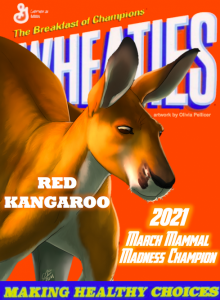By Serra Sowers. Mentored and edited by Emily Greenhalgh.
Weighing in at 85 kg and the largest marsupial, the red kangaroo faces the largest eagle in the Americas, the harpy eagle, with a two-meter wingspan and talons that can instantly crush its prey. Who would win?
According to the simulated play-by-play put together by scientists, the kangaroo’s predator punch response throws the eagle off and it flies away, accepting “defeat.” Although no one really knows how it would go down in real life, that was the outcome of the 2021 March Mammal Madness bracket (MMM) – a virtual tournament that ranks mammals in simulated battles to see which one might win.
Now, MMM is back and better than ever for their 10-year anniversary bracket, which was released on February 26.
Katie Hinde, associate professor and researcher of mammalogy and human evolutionary biology at Arizona State University, is the creator of this biology-based spin-off of March Madness, which she launched in 2013. She presented a topical lecture at the American Association for the Advancement of Science (AAAS) 2022 Annual Meeting on the use of games and stories in improving science engagement with public audiences. After giving a brief history of storytelling and human development in nature, she shared how MMM began.
The seed of the idea was planted in childhood, said Hinde, when her father turned on the TV to watch the “Bears vs. Bengals.” Like every child would be, she was disappointed to see that they were professional football players on the television and not real animals.
March Mammal Madness officially started in 2013 after she saw a bracket of “cute” animals, where people voted on what animal was cutest. MMM is different — the rules require that simulated matches are animals in fit condition, the “combat” does not have to result in death to be considered defeat and habitat matters for advantage in the later rounds of the bracket.
Once a bracket is proposed, scientists tweet out facts and stats of the animal, how the mammal encounters might play out step by step and which one will advance to the next level. Hinde and her team at Arizona State University provide resources for classrooms to make their own brackets and encourage educators to follow along with the official bracket that changes each year.
But it’s more than a thought experiment: the goal behind MMM is to engage audiences of all ages in animal science through gamification.
Since Hinde launched MMM in 2013, her team has shared more than 1,400 scientific resources for participants to learn more about the animals involved and has engaged upwards of 500,000 students. Further engagement from the most active participants online joined the team by creating artwork and narrating the battles.
The program’s growth of materials for educators expanded their engagement which now reaches an estimated 1% of high school students nationwide. March Mammal Madness has over 26,000 followers on Twitter and invested audiences that comment their reactions to matches with gifs.
“We have people reporting on how this experience sticks,” Hinde said. “One of the things we hear most frequently from teachers using this with learners is that students [no longer in the class] come back to get a bracket. This is so amazing and frankly not something I ever would have anticipated.”
Each year, MMM has taken on new challenges to make their tournament more accessible. Adding YouTube videos that keep even the youngest audiences engaged with puppets, a Twitter account that retweets the outcomes of the battles for audiences without hashtags and now translating materials to Spanish expands the reach of MMM around the world.
Thanks to a curriculum designed for educators or families, MMM can be shared anywhere from science classes to art classes. In 2021, inclusive materials showing silhouettes of the animals compared with people of different abilities and worksheets for elementary school participants were added to the program.
The gamification and growth of March Mammal Madness shows that science communication can be engaging and exciting for public audiences. Using this as a model, Hinde hopes that this kind of science engagement can extend beyond talking about animals into other fields of science.“If you build it, a community can emerge,” Hinde said. “March Mammal Madness was my reminder that science is worthwhile and fun and that there is a beautiful community that sustained me through my difficult work.”
This year’s March Mammal Madness battles start on March 8 at 8pm est. Follow them on Twitter @2022MMMletsgo to see who wins.
Serra Sowers is a sophomore honors student at the University of Florida pursuing a dual degree in journalism and sustainability studies. She currently works for as a Producer for WUFT, the NPR affiliate station in Gainesville and Produces “Two Bees in a Podcast” out of the UF Honey Bee Lab. She has also contributed and worked on staff at the Independent Florida Alligator. Follow her on Twitter @serrasowers or email her at serrasowers@ufl.edu.
Hero image: In honor of the 10th anniversary of March Mammal Madness, a new logo launched on Feb. 14 in a variety of color palettes. Credit: March Mammal Madness





